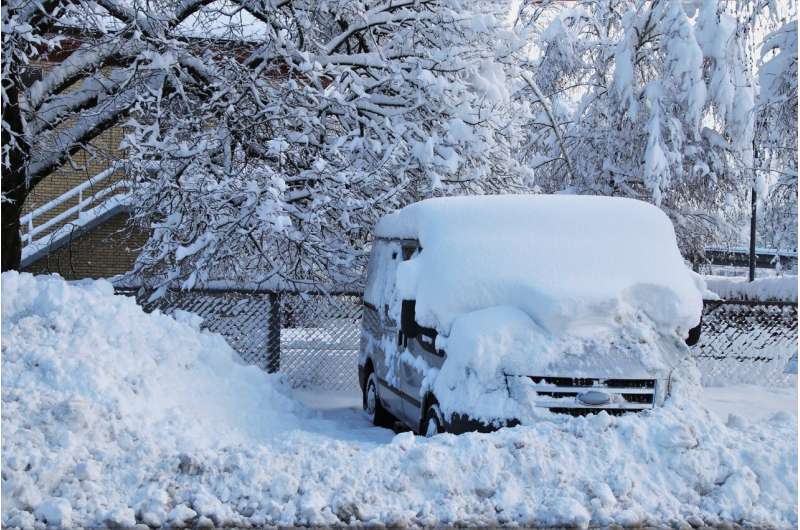Passenger car preheating produces as much particulate emissions as driving dozens of kilometers

A new study from Finland, conducted by the University of Eastern Finland and Tampere University, measured particulate emissions from passenger car preheating with an auxiliary heater in sub-zero conditions.
The preheating emissions were compared to calculated emissions from driving to determine the driving distance corresponding to the preheating emissions under current emissions standards.
Publishing their findings in Atmospheric Environment: X, the researchers measured auxiliary heater (AH) particulate emissions from the preheating of three gasoline and three diesel cars for a half an hour period. Preheating was carried out outdoors in sub-zero conditions, i.e., when preheating is recommended by the AH manufacturer.
In terms of particulate emissions, using an auxiliary heater for half an hour was equivalent to a 97-kilometer drive in a gasoline car, or to a 20-kilometer drive in a diesel car, under current emissions standards.
“When driving short distances, vehicle preheating can produce significantly higher particulate emissions than the actual drive, especially when considering that the during-drive emissions of most cars are much lower than the limits set in the emissions standards,” says Doctoral Researcher Henri Oikarinen of the University of Eastern Finland.
Auxiliary heaters produce a significant proportion of the preheating emissions on heater start-up and shut-down. This is particularly true for diesel operated heaters, for which steady heating (i.e., not turning the heater on and off) produces less than one third of the preheating emissions. In addition, a significant proportion of the particles produced by auxiliary heaters were observed to be in the smallest nanometric range: more than 50% of the particles produced by gasoline operated heaters, and more than 90% of the particles produced by diesel operated heaters, were in the below 23 nm range.
“However, preheating extends the life cycle of the vehicle and also makes driving more comfortable. These findings do not suggest that people should stop preheating their cars; instead, we could reduce the emissions from preheating by using similar emissions reduction methods that are in place for engine emissions, also for fuel-operated auxiliary heaters. Fuel-operated heaters could also be switched for electric ones,” Senior Researcher Panu Karjalainen of Tampere University says.
Current vehicle emissions standards apply to particles above 23 nanometers in size, i.e., the observed large quantity of particles below 23 nanometers in size is significant and raises the question of whether the emissions of these smaller particles, too, should be regulated.
In new cars, an auxiliary heater may be needed also during drive
Fuel-operated auxiliary heaters are used for heating vehicles in cold conditions. Auxiliary heaters are commonly known as “Webasto” or “Eberspächer,” which are the largest AH manufacturers. Particulate emissions from auxiliary heaters are not regulated by legislation, and research into these emissions is scarce. As a result, the impact of AH emissions on air quality and, consequently, on health and the global emissions budget, remains unknown. However, studying AH emissions is essential to gain an accurate understanding of the total emissions from vehicles.
In recent years, vehicle engine emissions have been significantly reduced by emission aftertreatment methods such as particulate filters and carburettors, and by improving engine efficiency. Existing auxiliary heaters, however, do not have similar aftertreatment methods that are in place for vehicle engine emissions.
The significance of AH emissions is emphasized especially for certain new vehicle models whose engine performance is so efficient that they do not produce enough heat during the drive in sub-zero conditions. In these cases, an auxiliary heater is needed for heating the vehicle also during the drive.
“Since AH emissions are currently not taken into account in vehicle emissions standards, it is possible to sub-optimize regulated vehicle engine emissions by using an auxiliary heater, even if this wouldn’t make sense in view of the total emissions,” Research Manager Santtu Mikkonen of the University of Eastern Finland says.
Surprisingly high emissions from fuel-powered auxiliary heaters in cars
Henri Oikarinen et al, Particle number, mass, and black carbon emissions from fuel-operated auxiliary heaters in real vehicle use, Atmospheric Environment: X (2022). DOI: 10.1016/j.aeaoa.2022.100189
Citation:
Passenger car preheating produces as much particulate emissions as driving dozens of kilometers (2022, October 28)
retrieved 28 October 2022
from https://phys.org/news/2022-10-passenger-car-preheating-particulate-emissions.html
This document is subject to copyright. Apart from any fair dealing for the purpose of private study or research, no
part may be reproduced without the written permission. The content is provided for information purposes only.
For all the latest Science News Click Here
For the latest news and updates, follow us on Google News.

